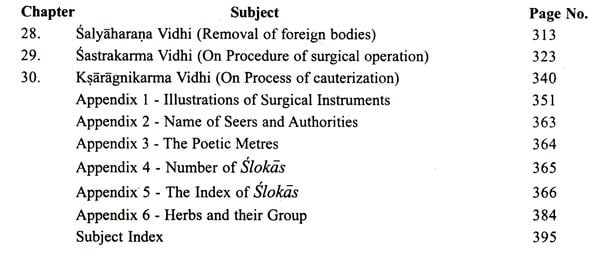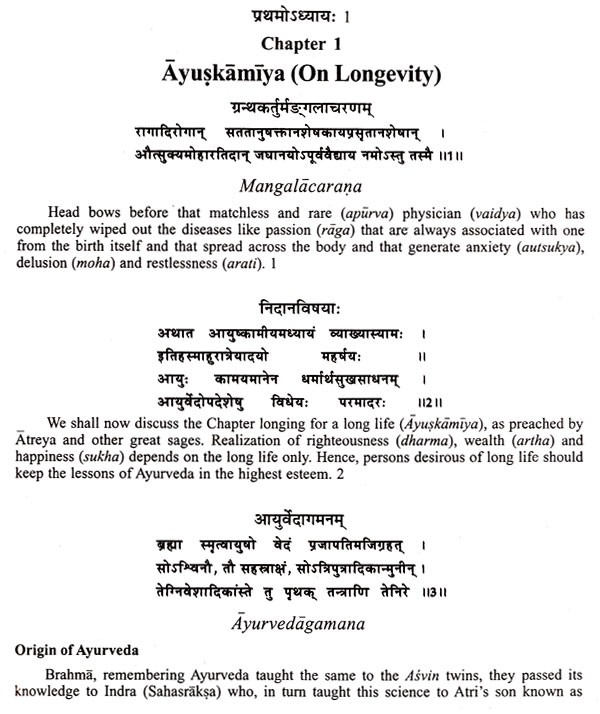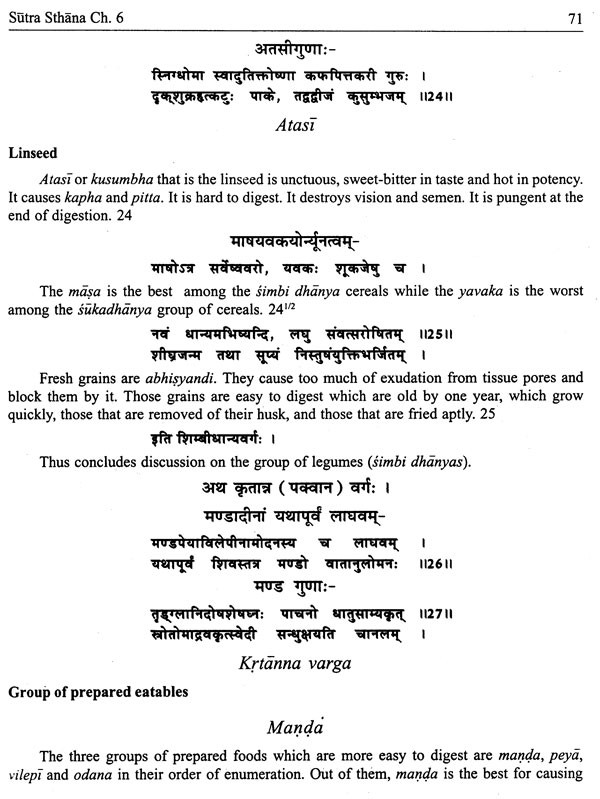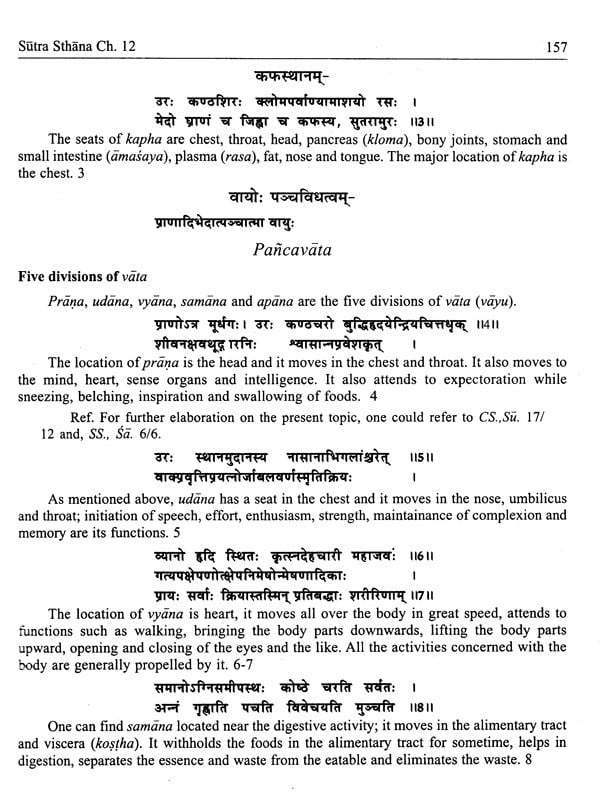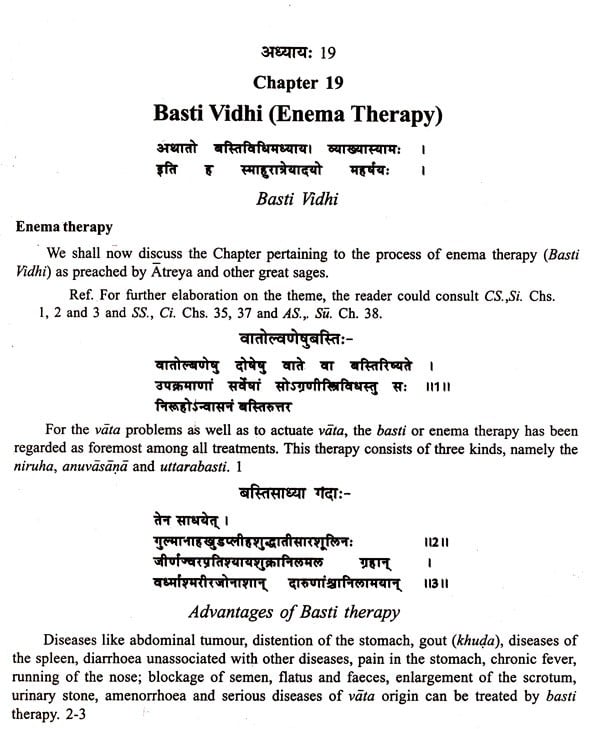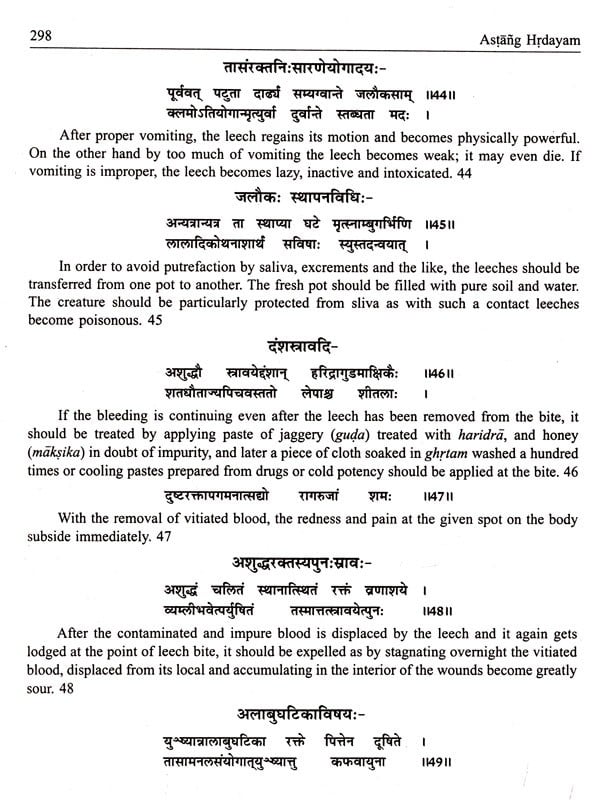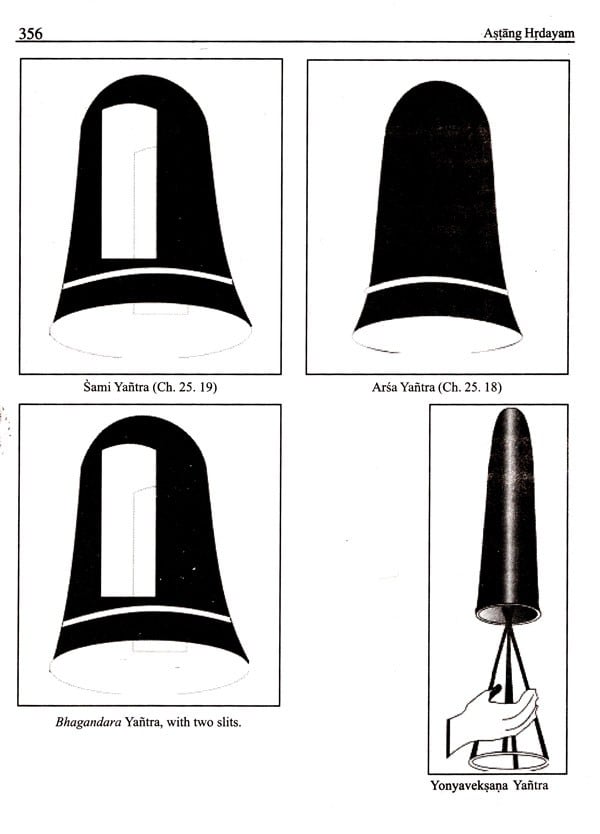
Astanga Hrdayam of Vagbhata (Sutra Sthana)
Book Specification
| Item Code: | NBZ241 |
| Author: | Kanjiv Lochan |
| Publisher: | Chaukhambha Publications |
| Language: | Sanskrit Text with English Translation |
| Edition: | 2017 |
| ISBN: | 9788189798154 |
| Pages: | 424 |
| Cover: | PAPERBACK |
| Other Details | 9.50 X 7.20 inch |
| Weight | 620 gm |
Book Description
The Ashtanga Hridaya or the Core of Eight Limb Science amply justifies its title as it indeed forms the basic principles and narratives of the Ayurveda, traditionally divided into eighty parts. The treatment of subject has been done in a to the point and fact of matter manner in this text. the descriptions presented in the work has been so impressive that it become one of the most popular texts of Ayurveda in India and beyond Availability of the largest number of commentaries and reviews based on Astāñga Hridayam testifies to the richness of the work.
The Sutra Sthan section is the preliminary chapter of the work. It presents the basic principles of Ayurveda. It stresses on the daily and seasonally regimens and highlights the major herbs and their usage. It also presents narrative on the methods of principle therapies applied by Ayurveda. One commanding the Sūtra Sthāna of Astāñga Hridayam could claim a clear and firm grasp of the Ayurvedic fundamentals.
Appreciating the practical utility of the text, the CCIM has recently included the Sūtra Sthāna of Astāñga Hridayam as part of the BAMS syllabus. There is several publications on this subject. Yet there was needed a work that could present an uncontaminated and plain translation of the book. The present work translated by Dr. Kanjiv Lochan aims at fulfilling this lacunae. It has been prepared in a way to present the narratives of the original texts in a lucid and simple reader-friendly English with least use of jargons. A critical edition of this work and translation of the rest of the Astāñga Hridayam are forthcoming.
The present work 'Āyurvediya Kriyā Sārīra' by a well known scholar and author of repute Prof. Dr. Yogesh Chandra Mishra, is a complete and comprehensive treatise, which deals with the various physiological aspects of human body. This is the first book in English which deals with the subject in all completeness and clarity, covering the various unique aspects of Ayurvediya Śarīra Kriyā Vijñana and also points out. where it differs from the modern physiology. The ‘Swāsthya' according to Ayurveda is not mere the balanced state of a few physical and chemical entities and the happiness of manas and ātman is the precondition of the holistic health, but the modern medical science does not accept the role of the soul atmā in health and treatment.
The another problem is regarding the translation of technical terms. Ancient Ayurvedic treatises are available in Sanskrta language and the exact translation of all the words in English or in any other language is not an easy task as the power and meaning of the words may differ according to their practical use as abhidha, laksnā and vyañjanā and decoding (and not only translation) of the various terms used in various references is an important but somehow a difficult job. The author has tried his best successfully one both of the points.
The book, no doubt, will prove as most useful asset to the U.G. and P.G. students and research scholars of Ayurveda. It will also prove helpful to all those, who are interested to keep in the basic fundamentals of the science as well as the art of living known as Ayurveda.
The author, being a senior professor in the subject of basic principals of Ayurveda, with a good background of sanskrta language and philosophy, the book bears a rare blend of conceptual authenticity, linguistic clarity and philosophical based scientific temper. No doubt, it is an unique attempt to fill the gap in the field of Ayurvedic literature
The readers may notice that the serial nos. of the various Slokas in the Aştanga Hrdaya's various manuscripts available have been paralleled by a different serial no. The involved passages are the interpolations made by various commentators of the text. These interpolations have been included in the present edition.
The problem of proof work of the text has been compounded by a multiplicity of readings of the work. We have tried our best to address this issue and are confident that even if it is not ultimate this edition of the first section of Astanga Hrdaya would be appreciated by the scholars.
The Astanga Hrdaya is representative of that current of scientific ideas in ancient India that appreciated the traditions and at the same time tried to project newer ideas. The first section of this text, namely the Sūtra Sthana forms the basics of the work. This section as well as the other parts of work have not only carried the ideas of Caraka and Susruta but have also sought acceptance of certain modifications on them. The readers would appreciate this and many other ma>vels of its author Vagbhata as the text is unfolded.
The present edition has been a result of a long-stretched labour. I have tried to consult all the available readings of this text. The pioneer work edited by Harishastry Paradakar with inclusion of Hemadri's Commentary has been particularly helpful. In this task, the support of A. Archana, S. Shekar and Ashok has been remarkable. Also is remembered the committed work of Ch. Guddu (who continued to work on the computer files of its draft).
Involvement of Shri Ritesh and Jitesh Gupta of Chaukhambha is also remembered, with gratitude.
‘Astanga Hrdaya,' literally the core of the Octopartrite Sciences, i. e. Ayurveda’, is one of the most significant texts on the subject. As repeatedly stressed upon by its author, this work consists of the core of the teachings and preaching contained in the texts of ancient Ayurvedic theorists including Agnives, Atreya, Harita, Bhela, Caraka and Susruta.
The originality of the Astanga Hrdaya is in its crisp and to the point presentation of the theme. It has as many as 120 chapters distributed through six sections. In all, these chapters contain approximately 8,000 verses. The exact counting of the verses or passages therein could not be tendered because the different texts of the work available today vary in this matter. The work in course of time rose to a great significance and as such a number of commentators laid their hands upon it. As a matter of fact, in terms of commentaries, the Astanga Hrdaya is richer even than the Caraka Text and Susruta Text. Within 100 year of its appearance, this treatise appeared to have caught the notice and attention of the practitioners and theorists of Ayurveda across India, and beyond. Earliest commentators of the text include such famous scholar as Candra, Indu, Aruņadatta and Bhatta Narahari. Across boarder, the Astanga Hrdaya was translated into Tibetan under the name “Rgud Bzi” during 755-797 AD. The work was also translated into Arabic and published with the name 'Astankar' during the reign of Khalifa Harun-al-Rashid (773-808 AD). The international popularity of the work is also evident by the fact that a Persian physician who authored Firdaus-al-hikma in 850 AD called Astanga Hridya as one of the major works on medicine.
Obviously, there are a number of interpolations to the original writing of the author of Astanga Hrdaya. These passages are, at times easily identifiable as they are independently numbered and they stand out of the numerical serial used in the original manuscript.
The first print of the work was brought under supervision of Dr. Anna Moresvara Kunte, MD, of Bombay in the year 1880. Between 1880 and 1892 as many as ten editions of the Astanga Hrdaya were published across India. In vernacular languages, the work was first published in Sanskrit and Bangla in 1886 by Vijayratna Sen Gupta who added the commentary of Arundatta to the publication. In the year 1889, a Gujarati translation was published by Behichar lal Nathuram, Ahmedabad. The first Hindi translation of the text was brought by Pandit Robi Dutta, Bombay in the year 1890. The next year, a Marathi translation was published by Ganesh Krishna Garde, Poona.
The Ashtanga Hridaya or the Core of Eight Limb Science amply justifies its title as it indeed forms the basic principles and narratives of the Ayurveda, traditionally divided into eighty parts. The treatment of subject has been done in a to the point and fact of matter manner in this text. the descriptions presented in the work has been so impressive that it become one of the most popular texts of Ayurveda in India and beyond Availability of the largest number of commentaries and reviews based on Astāñga Hridayam testifies to the richness of the work.
The Sutra Sthan section is the preliminary chapter of the work. It presents the basic principles of Ayurveda. It stresses on the daily and seasonally regimens and highlights the major herbs and their usage. It also presents narrative on the methods of principle therapies applied by Ayurveda. One commanding the Sūtra Sthāna of Astāñga Hridayam could claim a clear and firm grasp of the Ayurvedic fundamentals.
Appreciating the practical utility of the text, the CCIM has recently included the Sūtra Sthāna of Astāñga Hridayam as part of the BAMS syllabus. There is several publications on this subject. Yet there was needed a work that could present an uncontaminated and plain translation of the book. The present work translated by Dr. Kanjiv Lochan aims at fulfilling this lacunae. It has been prepared in a way to present the narratives of the original texts in a lucid and simple reader-friendly English with least use of jargons. A critical edition of this work and translation of the rest of the Astāñga Hridayam are forthcoming.
The present work 'Āyurvediya Kriyā Sārīra' by a well known scholar and author of repute Prof. Dr. Yogesh Chandra Mishra, is a complete and comprehensive treatise, which deals with the various physiological aspects of human body. This is the first book in English which deals with the subject in all completeness and clarity, covering the various unique aspects of Ayurvediya Śarīra Kriyā Vijñana and also points out. where it differs from the modern physiology. The ‘Swāsthya' according to Ayurveda is not mere the balanced state of a few physical and chemical entities and the happiness of manas and ātman is the precondition of the holistic health, but the modern medical science does not accept the role of the soul atmā in health and treatment.
The another problem is regarding the translation of technical terms. Ancient Ayurvedic treatises are available in Sanskrta language and the exact translation of all the words in English or in any other language is not an easy task as the power and meaning of the words may differ according to their practical use as abhidha, laksnā and vyañjanā and decoding (and not only translation) of the various terms used in various references is an important but somehow a difficult job. The author has tried his best successfully one both of the points.
The book, no doubt, will prove as most useful asset to the U.G. and P.G. students and research scholars of Ayurveda. It will also prove helpful to all those, who are interested to keep in the basic fundamentals of the science as well as the art of living known as Ayurveda.
The author, being a senior professor in the subject of basic principals of Ayurveda, with a good background of sanskrta language and philosophy, the book bears a rare blend of conceptual authenticity, linguistic clarity and philosophical based scientific temper. No doubt, it is an unique attempt to fill the gap in the field of Ayurvedic literature
The readers may notice that the serial nos. of the various Slokas in the Aştanga Hrdaya's various manuscripts available have been paralleled by a different serial no. The involved passages are the interpolations made by various commentators of the text. These interpolations have been included in the present edition.
The problem of proof work of the text has been compounded by a multiplicity of readings of the work. We have tried our best to address this issue and are confident that even if it is not ultimate this edition of the first section of Astanga Hrdaya would be appreciated by the scholars.
The Astanga Hrdaya is representative of that current of scientific ideas in ancient India that appreciated the traditions and at the same time tried to project newer ideas. The first section of this text, namely the Sūtra Sthana forms the basics of the work. This section as well as the other parts of work have not only carried the ideas of Caraka and Susruta but have also sought acceptance of certain modifications on them. The readers would appreciate this and many other ma>vels of its author Vagbhata as the text is unfolded.
The present edition has been a result of a long-stretched labour. I have tried to consult all the available readings of this text. The pioneer work edited by Harishastry Paradakar with inclusion of Hemadri's Commentary has been particularly helpful. In this task, the support of A. Archana, S. Shekar and Ashok has been remarkable. Also is remembered the committed work of Ch. Guddu (who continued to work on the computer files of its draft).
Involvement of Shri Ritesh and Jitesh Gupta of Chaukhambha is also remembered, with gratitude.
‘Astanga Hrdaya,' literally the core of the Octopartrite Sciences, i. e. Ayurveda’, is one of the most significant texts on the subject. As repeatedly stressed upon by its author, this work consists of the core of the teachings and preaching contained in the texts of ancient Ayurvedic theorists including Agnives, Atreya, Harita, Bhela, Caraka and Susruta.
The originality of the Astanga Hrdaya is in its crisp and to the point presentation of the theme. It has as many as 120 chapters distributed through six sections. In all, these chapters contain approximately 8,000 verses. The exact counting of the verses or passages therein could not be tendered because the different texts of the work available today vary in this matter. The work in course of time rose to a great significance and as such a number of commentators laid their hands upon it. As a matter of fact, in terms of commentaries, the Astanga Hrdaya is richer even than the Caraka Text and Susruta Text. Within 100 year of its appearance, this treatise appeared to have caught the notice and attention of the practitioners and theorists of Ayurveda across India, and beyond. Earliest commentators of the text include such famous scholar as Candra, Indu, Aruņadatta and Bhatta Narahari. Across boarder, the Astanga Hrdaya was translated into Tibetan under the name “Rgud Bzi” during 755-797 AD. The work was also translated into Arabic and published with the name 'Astankar' during the reign of Khalifa Harun-al-Rashid (773-808 AD). The international popularity of the work is also evident by the fact that a Persian physician who authored Firdaus-al-hikma in 850 AD called Astanga Hridya as one of the major works on medicine.
Obviously, there are a number of interpolations to the original writing of the author of Astanga Hrdaya. These passages are, at times easily identifiable as they are independently numbered and they stand out of the numerical serial used in the original manuscript.
The first print of the work was brought under supervision of Dr. Anna Moresvara Kunte, MD, of Bombay in the year 1880. Between 1880 and 1892 as many as ten editions of the Astanga Hrdaya were published across India. In vernacular languages, the work was first published in Sanskrit and Bangla in 1886 by Vijayratna Sen Gupta who added the commentary of Arundatta to the publication. In the year 1889, a Gujarati translation was published by Behichar lal Nathuram, Ahmedabad. The first Hindi translation of the text was brought by Pandit Robi Dutta, Bombay in the year 1890. The next year, a Marathi translation was published by Ganesh Krishna Garde, Poona.
**Contents and Sample Pages**

